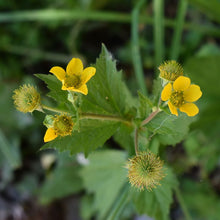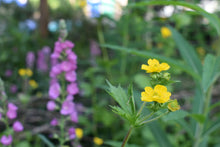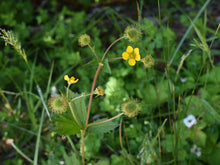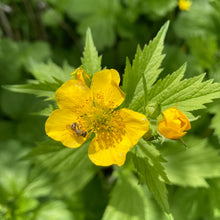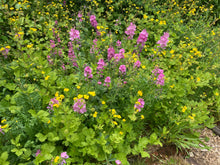
Geum macrophyllum
Large-leaved avens, aka Oregon avens, is an effortless perennial wildflower that will happily thrive in a wide range of growing conditions, to the delight of backyard bees and butterflies. Its foliage is vibrant green and hardy, with generally rounded leaves at the bottom of the plant that become sharply serrated as they go up. The five-petaled flowers are an exuberant burst of yellow on towering, reddish stalks. Miraculously, each flower bears an “invisible” black dot at their base that can only be seen to the human eye with the assistance of ultraviolet light. However, many species of pollinators can see it just fine and use it as a “nectar guide” to guide them into the heart of the flower.
- Plant type/canopy layer: deciduous, perennial, herbaceous plant
- Size at maturity: up to 36” tall, equally wide
- Light requirements: full sun, part sun/part shade, full shade
- Moisture requirements: moist soil, prefers well-drained
- Bloom time: April - August (May - July in the Portland metro area)
- Growth rate/ease: medium growth rate, easy to grow
- Wildlife support: flowers attract and provide nectar to adult butterflies, bees and other insect pollinators; overall plant is a caterpillar host plant and larval food source for native moths and butterflies
- Native habitat/range: grows in moist woods and woodland edges, streambanks and riparian areas, and meadows from southern Alaska to Baja California, east across the Rockies, the Great Plains, to the Sierra Nevada in California and across Canada to the Atlantic coast. In the Pacific Northwest, it’s found on both sides of the Cascade crest and at the coast. Portland Plant List - yes
- Special features & uses: pollinator favorite; medicinally used by indigenous folks, including the Bella Coola, Chehalis, Hesquiat, Quileute, and others, as a decoction of root to relieve stomach pain, a poultice of chewed or bruised leaves for skin boils and cuts, an infusion of leaves as a contraceptive, and raw leaves have been chewed during labor; landscape uses include greenroofs, pollinator gardens and woodland gardens
Gardening with Large-Leaved Avens: These joyful yellow wildflowers are arguably the easiest native wildflower seeds to grow in a garden setting. Though it prefers moist, well-drained soil, it is adaptable to sand, clay and everything in between, plus it tolerates drought and some seasonal flooding. It is a reliable self-seeder that will proliferate and spread vigorously - though planting it in dry areas with less sun will discourage unruly growth. Try adding it to your woodland or meadow garden, intermixed with other wildflowers to provide three seasons of pollinator magic. In Sparrowhawk's garden, we like pairing the large-leaved avens with pink rose checkermallow for a bright and showy low-maintenance 3' tall display in June and July.
Seed Sowing Instructions: Recommend sowing between September - November or in March so that seeds will benefit from seasonal rains. Scatter seed on loose-weed free soil. Seed can be lightly raked in to increase seed-to-soil contact, but be careful not to cover the seed with more than 1/4" soil. It is not believed to require any cold stratification, though a longer period of cooler temps may enhance germination. If sowing later, i.e. April or May, seeds will benefit from supplemental water to encourage strong growth the first year. Each packet contains approximately 425 seeds.
Photo Credits 1-3: Nikkie West, Sparrowhawk Native Plants
Photo Credits 4-5: Tracy Cozine, Sparrowhawk Native Plants





